Crown Sovereign Warrented Scales Antique Gold Lustre Victorian Full & Half Coin

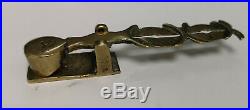
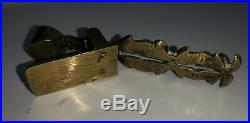
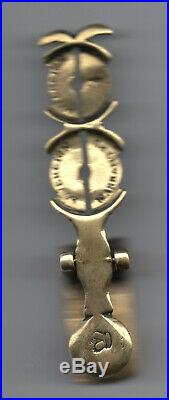

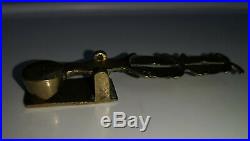
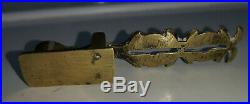
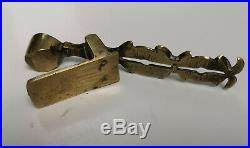

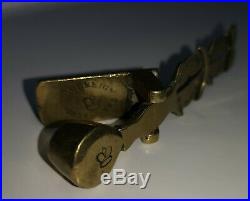
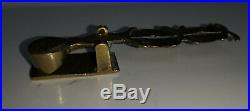

From the Victorian Times late nineteenth century. They have the Crown Hall Mark Stamped Twice once on the main weight and once underneath.
With the words "Sovereign Warented" It also has a crown design over the main weight. Made of Brass with a Golden Lustre. Walk-in to any shop in the 18th or 19th century and you would have most likely seen a sovereign balance sitting on the shop keepers counter.
Used in business during the Victoria and Edwardian times, they have now become decorative display piece with an historical story. A fitting item to go with your sovereigns. The balance has two platters, one for full and one for half sovereigns. The slot in the centre of each platter is to check the thickness of a coin.If the coin didnt pass through the slot, it was too thick and therefore not genuine. Placing the coin onto the balance would verify the diameter of the coin. Too wide & it wouldnt sit inside the platter. Finally, if the balance failed to settle horizontal, the weight of the coin was incorrect and therefore rejected. Put a Full Soverign or a Half Soverign on one side and it the scales balance it is the correct weight The Dimensions are 100mm x 15mm x 25mm The Weight on the Scale Weights the same weight a a sovereign.
In Good Condition given it is over 1 00 years old. Would make an Excellent Lucky Charm or Collectible Keepsake Souvenir. I have got married recently and need to raise funds to meet the costs also we are planning to move into a house together.
Check out my other items. Western Europe takes up to 2 weeks. Eastern Europe up to 5 weeks. North America up to 6 weeks. South America, Africa and Asia up to 8 weeks and. Australasia up to 12 weeks. For that Interesting Conversational Piece, A Birthday Present, Christmas Gift, A Comical Item to Cheer Someone Up or That Unique Perfect Gift for the Person Who has Everything....You Know Where to Look for a Bargain! Nd I Will Reply ASAP. The Countries I Send to Include.
Minor Pacific Islands (US) U. Virgin Islands (US) Uganda Ukraine United Arab Emirates United Kingdom United States Uruguay Uzbekistan Vanuatu Vatican City Venezuela Vietnam Wallis and Futuna (FR) Yemen Zambia Zimbabw.
The sovereign is a gold coin of the United Kingdom, with a nominal value of one pound sterling but in practice used as a bullion coin. Named after the English gold sovereign, last minted in 1604, the name was revived with the Great Recoinage of 1816. [1] Minting these new sovereigns began in 1817.
The gold content was fixed by the coin act of 1816 at 1320/5607 (0.235420) troy ounces (7.322381 g), nearly equivalent to 113 grains. This weight has remained practically constant to the present day (some minute changes have resulted from its legal redefinition in the metric system of weights). [2] Sovereigns were minted in the United Kingdom from 1817 to 1917, in 1925, and from 1957. Australia, India, Canada, and South Africa all occasionally minted the coins. In 2013 the Royal Mint announced that it would restart the manufacture of sovereigns in India to cater to the Indian market. [3] These sovereigns will be minted by Indian gold producer MMTC-PAMP to Royal Mint specification. [3] MMTC-PAMP is a joint venture between MMTC Ltd and PAMP of Switzerland. In addition to the sovereign, the Royal Mint also struck ten-shilling half sovereigns, two-pound double sovereigns, and five-pound quintuple sovereign coins. Only the sovereign and the half sovereign were commonly struck for circulation. In 2009, The Royal Mint released a new coin in the sovereign series: the quarter-sovereign, similar in some ways to the original gold English crown of the rose. Sovereigns minted since 1817 have been produced according to the coin act of 1816: Weight: 7.988052 g calculated from original definition; the coin act of 1971 adjusted the standard to exactly 7.98805 g. [2] Thickness: 1.52 mm[4] Diameter: 22.05 mm[4] Fineness: 22 carat = 916 / 1000 (± 2/1000[2]) Gold Content: 7.322381 g = 0.235420 (exactly: 1320/5607) troy ounces or 113.0016 grains original definition; actual gold content may differ due to allowed tolerances and abrasion, see Reminting worn coins below. Sovereigns were produced as follows: London: 18171917, 1925, 1957 onwards Melbourne: 18721931 Sydney: 18551926 Perth: 18991931 Bombay: 1918 only Ottawa: 19081919 Pretoria: 19231932 Melbourne During the 1850s, Victoria alone contributed more than one-third of the worlds gold output. Although a Mint opened in Sydney in 1855, it had difficulty keeping pace with the output of the goldfields and in 1871 a new branch of the Royal Mint opened in Melbourne. Melbourne sovereigns carry a small M to identify them. However, it soon became apparent that it would be easier to refine the gold and turn it into coins at source, rather than transport it to Britain and have it turned into coins there. Sydney, Melbourne, and Adelaide each submitted to be the venue of a branch of the Royal Mint and after some deliberation the British government awarded it to Sydney, which began issuing coins in 1855. This mint issued coins with its own design from 1855 until 1870 then, in 1871 the Royal Mint insisted that all gold sovereigns regardless of Mint should carry the British design.The coins minted by Sydney carry a small S mintmark to identify them for quality control purposes. Perth The gold mines at Kalgoorlie and Coolgardie in Western Australia, once discovered, quickly became recognised as two of Australias richest. The problems of transporting the raw gold over 2,100 miles to the nearest Mint in Melbourne were obvious and so a new branch of the Royal Mint was authorised and opened in 1899. Sovereigns minted at Perth carry a small P mintmark. Bombay (India) Another branch of the British Mint was established in Bombay in India in 1918, where the demand for sovereigns was particularly high.
The Bombay mint only produced coins for one year and all are dated 1918. Nonetheless, the Indian mint struck more sovereigns (approximately 1.3 million) in its single year of operation than the Ottawa branch managed in more a decade. Sovereigns from the Bombay mint were distinguished by the letter I for India. For some time all of Canadas coinage was struck in England but these new gold strikes made this impractical. In 1908 a Canadian branch of the British Royal Mint was opened in Ottawa. As well as producing silver and base metal coins for everyday use, the new Canadian mint also turned the recently discovered gold into sovereigns striking intermittently between 1908 and 1919. Sovereigns of this mint carry a small C mintmark. Pretoria (South Africa) The next, and final, branch mint was established in Pretoria (South Africa) in 1923. Like the Australian and Canadian mints, this was set up to turn locally mined gold into coins. Significant quantities of gold were discovered in Johannesburg in 1886, setting off another mass migration as speculators, prospectors, fortune-seekers, and adventurers from all over the world descended upon the region. By the end of the 1890s the area was responsible for a significant percentage of global gold production. Sovereigns, identical to the British coins except for the inclusion of an SA mintmark, were struck at Pretoria between 1923 and 1932. From 1672 he governed as Stadtholder William III of Orange (Dutch: Willem III van Oranje) over Holland, Zeeland, Utrecht, Gelderland, and Overijssel of the Dutch Republic.From 1689 he reigned as William III over England and Ireland; it is a coincidence that his regnal number (III) was the same for both Orange and England. As King of Scotland, he is known as William II. [2] He is informally known by sections of the population in Northern Ireland and Scotland as "King Billy". [3] In what became known as the "Glorious Revolution", on 5 November 1688 William invaded England in an action that ultimately deposed King James II & VII and won him the crowns of England, Scotland and Ireland. In the British Isles, William ruled jointly with his wife, Mary II, until her death on 28 December 1694.
The period of their joint reign is often referred to as "William and Mary". A Protestant, William participated in several wars against the powerful Catholic king of France, Louis XIV, in coalition with Protestant and Catholic powers in Europe. Many Protestants heralded him as a champion of their faith. Largely because of that reputation, William was able to take the British crowns when many were fearful of a revival of Catholicism under James. William's victory over James at the Battle of the Boyne in 1690 is still commemorated by the Orange Order.
His reign marked the beginning of the transition from the personal rule of the Stuarts to the more Parliament-centred rule of the House of Hanover. Prince of Orange Reign 4 November 1650[1] 8 March 1702 Predecessor William II Successor John William Friso Stadtholder of Holland, Zeeland, Utrecht, Gelderland and Overijssel Reign July 1672 8 March 1702 Predecessor William II Successor William IV King of England, Scotland and Ireland more... Reign 13 February 1689 8 March 1702 Coronation 11 April 1689 Predecessor James II & VII Successor Anne Co-monarch Mary II Spouse Mary II of England House House of Orange-Nassau Father William II, Prince of Orange Mother Mary, Princess Royal Born 4 November 1650 N. 14 November 1650[1] Binnenhof, The Hague Died 8 March 1702 (aged 51) N.
19 March 1702 Kensington Palace, London Burial Westminster Abbey, London William III of England and Orange & II of Scotland House of Orange-Nassau Cadet branch of the House of Nassau Born: 4 November 1650 Died: 8 March 1702 Regnal titles Vacant Title last held by William II Prince of Orange Baron of Breda 4 November 1650 8 March 1702 Succeeded by John William Friso Vacant Title last held by James II & VII King of England King of Ireland 13 February 1689 8 March 1702 with Mary II (until 28 December 1694) Succeeded by Anne King of Scotland 11 May 1689 8 March 1702 with Mary II (until 28 December 1694) Political offices Vacant First Stadtholderless Period Title last held by William II Stadtholder of Holland and Zeeland 16721702 Vacant Second Stadtholderless Period Title next held by William IV Stadtholder of Utrecht 16741702 Stadtholder of Guelders and Overijssel 16751702 Preceded by James II Lord High Admiral 1689 Succeeded by The Earl of Torrington [hide] v t e Stadtholders of Guelders Willem van Egmond Willem van Egmond jr. Philip I of Croÿ-Chimay Willem van Egmond jr. Adolf III of Nassau-Wiesbaden-Idstein Jan V of Nassau-Vianden-Diez Philip of Burgundy Floris van Egmond René of Châlon Philip de Lalaing Philip de Montmorency, Count of Hoorn Karel van Brimeu Gillis van Berlaymont John VI of Nassau-Dillenburg Willem IV van den Bergh Adolf van Nieuwenaar Maurice of Nassau Frederick Henry of Orange William II of Orange interregnum William III of Orange interregnum William IV of Orange William V of Orange [hide] v t e Stadtholders of Holland, Zeeland and (from 1528) Utrecht Hugo van Lannoy Willem van Lalaing Gozewijn de Wilde Jan van Lannoy Lewis de Bruges Wolfert VI van Borselen Joost van Lalaing Jan III van Egmond Henry III of Nassau-Breda Antoon van Lalaing René of Châlon Louis of Flanders Maximilian II of Burgundy William of Orange Maximilian of Hennin Philip of Noircarmes William of Orange Adolf van Nieuwenaar (Utrecht only) Maurice of Nassau Frederick Henry of Orange William II of Orange interregnum William III of Orange interregnum William IV of Orange William V of Orange [hide] v t e Stadtholders of Overijssel Georg Schenck van Toutenburg Maximiliaan van Egmond Jan van Ligne Karel van Brimeu Gillis van Berlaymont Caspar van Robles Georges van Lalaing Francisco Verdugo Adolf van Nieuwenaar Maurice of Nassau Frederick Henry of Orange William II of Orange William III of Orange William IV of Orange William V of Orange [hide] v t e Stadtholders of Drenthe Christoph van Moers Jasper van Marwijck Charles, Duke of Guelders Ludolf Coenders Georg Schenck van Toutenburg Maximiliaan van Egmond Jan van Ligne Karel van Brimeu Gillis van Berlaymont Caspar van Robles Georges van Lalaing Francisco Verdugo Willem Lodewijk of Nassau-Dietz Maurice of Nassau Ernst Casimir Hendrik Casimir I Willem Frederik Hendrik Casimir II William II of Orange William III of Orange William IV of Orange William V of Orange [hide] v t e English, Scottish and British monarchs Monarchs of England before 1603 Monarchs of Scotland before 1603 Æthelstan Edmund I Eadred Eadwig Edgar the Peaceful Edward the Martyr Æthelred the Unready Sweyn Forkbeard Edmund Ironside Cnut the Great Harold Harefoot Harthacnut Edward the Confessor Harold Godwinson Edgar the Ætheling William I William II Henry I Stephen Matilda Henry II Henry the Young King Richard I John Henry III Edward I Edward II Edward III Richard II Henry IV Henry V Henry VI Edward IV Edward V Richard III Henry VII Henry VIII Edward VI Jane Mary I and Philip Elizabeth I Kenneth I MacAlpin Donald I Constantine I Áed Giric Eochaid Donald II Constantine II Malcolm I Indulf Dub Cuilén Amlaíb Kenneth II Constantine III Kenneth III Malcolm II Duncan I Macbeth Lulach Malcolm III Canmore Donald III Duncan II Donald III Edgar Alexander I David I Malcolm IV William I Alexander II Alexander III Margaret First Interregnum John Second Interregnum Robert I David II Edward Robert II Robert III James I James II James III James IV James V Mary I James VI Monarchs of England and Scotland after the Union of the Crowns in 1603 James I & VI Charles I Commonwealth Charles II James II & VII Mary II and William III & II Anne British monarchs after the Acts of Union 1707 Anne George I George II George III George IV William IV Victoria Edward VII George V Edward VIII George VI Elizabeth II Weighing scales (usually just "scales" in UK and Australian English, "weighing machine" in South Asian English or "scale" in US English) is a measuring instrument for determining the weight or mass of an object. Specialized medical scales including infant medical scales, and bathroom scales are used to measure the body weight of human beings. The name scales derives from the pair of scales or dishes in which objects to be weighed and the weights / masses against which to weigh them are placed. The Oxford English Dictionary defines scales as Apparatus for weighing.The pan, or each of the pans, of a balance. [1] Spring balances or spring scales measure force or weight by balancing the force due to gravity against the force on a spring, whereas a balance or pair of scales using a balance beam compares masses by balancing the force of gravity (weight) due to the mass of an object against the force due to gravity (weight) of a known mass. Either type of balance or scales can be calibrated to read in units of force (weight) such as Newtons, or in units of mass such as kilograms, but the balance or pair of scales using a traditional balance beam to compare masses will read correctly for mass even if moved to a place with a different (non-zero) gravitational field strength (but would then not read correctly if calibrated in units of force), while the spring balance would read correctly in force in a different gravitational field strength (but would not read correctly if calibrated in units of mass). Measuring and alignment tools architect's scale beam compass caliper chalk box combination square compass coordinate-measuring machine drafting machine engineer's scale flat spline jig laser level laser line level laser measuring tool lesbian rule micrometer plumb-bob protractor ruler set square sliding T bevel spirit level steel square stencil straightedge T-square tape measure theodolite vise weighing scale yardstick An antique (Latin: antiquus; "old", "ancient") is an old collectable item. It is collected or desirable because of its age, beauty, rarity, condition, utility, personal emotional connection, and/or other unique features.
It is an object that represents a previous era or time period in human society. It is common practice to define "antique" as applying to objects at least 100 years old. Antiques are usually objects that show some degree of craftsmanshipor a certain attention to design, such as a desk or an early automobile. Antique dealers often belong to national trade associations, many of which belong to CINOA, a confederation of art and antique associations across 21 countries that represents 5,000 dealers. The item "Crown Sovereign Warrented Scales Antique Gold Lustre Victorian Full & Half Coin" is in sale since Thursday, December 5, 2019.
This item is in the category "Collectables\Tools & Collectable Hardware\Collectable Scales". The seller is "notinashyway" and is located in Manchester. This item can be shipped worldwide.
